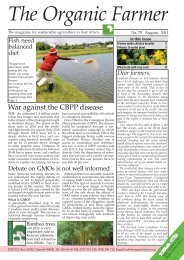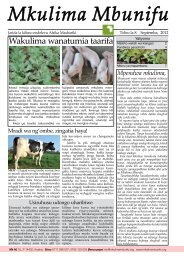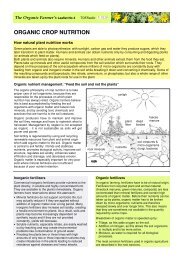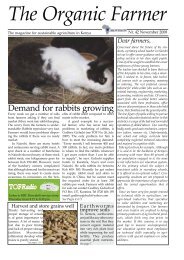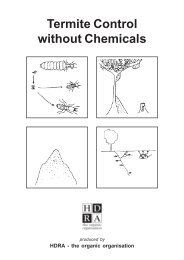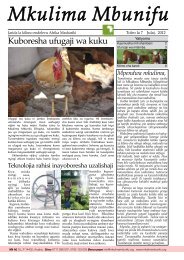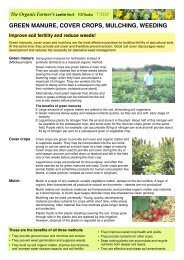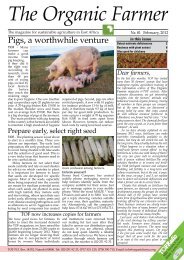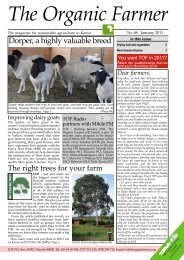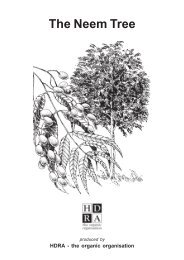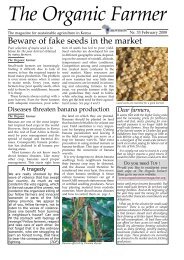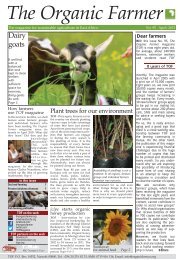TOF, Issue No 15, July 2006 - Infonet-Biovision
TOF, Issue No 15, July 2006 - Infonet-Biovision
TOF, Issue No 15, July 2006 - Infonet-Biovision
Create successful ePaper yourself
Turn your PDF publications into a flip-book with our unique Google optimized e-Paper software.
The Organic FarmerThe newspaper for sustainable agriculture in Kenya Nr. <strong>15</strong> <strong>July</strong>, <strong>2006</strong>Kazi mingi,malipo kidogoMany farmers in Kenya face the samestruggle every day: Will my farmbring enough income to sustain myfamily? To pay school fees? To affordthe long overdue repair of the roof ofmy house? While the governmenthas put the minimum salary for theagricultural sector optimistically at4812 Kenyan Shillings per month,most farmers and their families stillsurvive with not even half of thisamount. "We have no money to buyseeds or bring our produce to themarkets," are only some issues TheOrganic Farmer hears its readers complainabout. Bad roads, pests and diseases,losing lots of money to middlemenand unreliable rainfall areother problems which make farmingin Kenya so challenging.Why do the Kenyan farmers workso hard yet earn so little, and whatcan be done to change this situation?We try to answer this questions onpage 3.(<strong>TOF</strong>)A new maize disease in KenyaThe grey leaf spot disease hasalready spread to important maizegrowingareas of the country.Dr. Z. M. KinyuaMaize farmers face a new disease thathas recently hampered the productionof maize grain. The grey leaf spot disease,which is caused by a fungusknown as Cercospora zeaemaydis,appears in the form of necrotic lesions(dry brown-yellow wounds orpatches) on the leaves of maize plants.in this issueCash crop 2Asparagus production has improvedincome for farmers in Gilgil.Plant protection 5Combined with EM, plantextracts feed your crops.Natural fertilizers 6If well composted, chicken manure isa valuable source of nutrients.The wounds may merge to causeextensive leaf blighting (burnt appearance).This reduces the plant’s abilityto manufacture its own food from sunlight(photosynthesis). It causes poorgrain filling of the maize cobs andtherefore reduces the maize yields andfarmers income.Mid-altitude areas affectedThe grey leaf spot disease, which wasnot known to occur in Kenya before itsfirst appearance in 1995, has become agreat threat to maize production in thewestern and Rift Valley regions of thecountry, where the highest proportionof maize grain originates. Most of themaize in Kenya is produced in midaltitudeareas, which unfortunately arealso favourable for the development ofthe disease.The devastating disease has reachedepidemic levels in important maizeproducingareas such as Kakamega,Vihiga, Kisii, Migori, Lugari, Bungoma,Bomet and Nandi districts.Other mid-elevation areas are alsoaffected, but with less damage tomaize crops. Continued on page 2Dear farmers,Every day, local newspapers are full ofstories about our fellow Kenyansentrusted with leadership positions ingovernment, parastatals, companiesand even civil society organizations,who loot or mismanage public funds.Corruption is so widespread that itnow threatens every sector in our country.The agricultural sector has notbeen spared. Look at what used to beour best performing co-operative societies—they have collapsed owing tomismanagement by the farmers electedto lead them. We have emphasised onseveral occasions the need for farmersto come together and solve some of theday-to day problems that they face inproduction and marketing. Howeversome of these groups also have problemsof leadership. This is because somefarmers’ group leaders put their owninterests before those of their members.There are those who fight for leadershippositions for personal gain. Indeed, it isour feeling that some of these groupsare set up for selfish motives.Such group leaders will attend workshopsand conferences that deliberateon the critical issues that affect farmers,but they will never pass this informationon to fellow farmers when they goback home. They attend these meetingsonly because of the benefits theyreceive, like allowances and per diems.Lack of transparency in financialmanagement is another problem. Thosegiven the responsibility of marketingvarious commodities on behalf of fellowfarmers often short-change theirfriends. The rot also extends to outgrowercompanies that contract farmersto grow commodities for local andexport markets. Many of these companiesnever pay farmers the true value oftheir produce.From the many letters we get fromfarmers, we can clearly see that they area demoralised lot. Our advice to farmersis that they should wake up to theserealities and find ways to overcomethem. Only people with a known trackrecord should be given leadership positions.Group members should alwaysdemand accountability from their leaders.How can we complain of exploitationof smallscale farmers if the farmersthemselves cannot help each other?
Nr. <strong>15</strong> <strong>July</strong> <strong>2006</strong> The Organic Farmer 3Why don't Kenyan farmers earn enough?Despite working hard toimprove their income, Kenyanfarmers face many problems in realizingtheir goals.Anja BengelstorffFarming is a daily, labour-intensivetask, and many Kenyans and Kenyanfarmers are hardworking people.However, according to a Governmentstatistic, 87 % of all poor householdslive in rural areas, where their mainactivities are in agriculture, yet abouthalf of all Kenyans might not haveenough food for their families. Weneed to take a closer look at howfarming in Kenya is practised.The importance of the agriculturalsector in Kenya is clear: It providesthe livelihoods for close to threequartersof the population, itaccounts for 60% of the country'sexport earnings and contributes 26%to the Gross Domestic Product (GDP)directly, plus another 27% indirectlythrough linkages with other sectorssuch as manufacturing and distribution.During the first two decadesafter Independence, the economyrecorded an impressive growth rateof 6%, with the agricultural sectorplaying the dominant role. Howeverthis declined to only 3.5% in the1980s and to even less in the late1990s and early 2000s, to only 1.3%.What has happened?Marketing neglectedFor too long, the experts agree, theGovernment's policies have focusedtoo strongly on producing agriculturalgoods, and by far not enoughattention has been paid on marketingthem. This means that vegetables,fruits and other crops were producedin large amounts, but the farmerswere not able to find enough buyers.Talking to farmers all over Kenya,<strong>TOF</strong> knows that this is still one of thebiggest obstacles in farming. For along time, there was not a singleexpert in marketing in the Ministry ofAgriculture. It is only recently thatthe Government took action in thisregard. In its ambitious "Strategy forRevitalizing Agriculture", launchedin 2004, the Government acknowledgedthe key role of domestic marketingand promised to give priorityto developing the infrastructure andto the training of farmers. In addition,the Ministry of Agriculture nowhas an Agribusiness Division.Agronomist Dr. Joseph Kariuki fromthe consultancy firm AgrisystemsLtd. knows that despite the goodwill, however, funds are lacking tomake these plans come true.To complicate matters further, theagricultural sector is currently governedby about 130 pieces of legislation,many of which are obsolete/outof date, or inconsistent. The issue ofland ownership is another "hotpotato" which needs to be worked on.Soil quality declining …Apart from governmental regulations,the natural conditions in Kenyaare raising problems for farmers.Because the available land has to providefood for an increasing numberof people, it is getting overused, andthe soil's fertility and productivityare declining. As a result, the soil isbecoming useless for farming purposes,erosion occurs more frequentlyand severely, and the semiaridand arid portions of land aregrowing. According to Joseph Kariukifrom Agrisystems, only 20% ofthe Kenyan land is suitable for farmingtoday. Furthermore, the rainfallin Kenya is less available than in ourneighbouring countries. He thereforestrongly suggests that farmers betrained in conservation techniques.… and not enough trainingAnother reason why agriculture isnot keeping pace with populationgrowth, if not the most importantone, is the fact that Kenyan farmersdo not consider their profession as abusiness. "Most of them see it as away of life", Joseph Kariuki says.Another expert, Reimund Hoffmannfrom the German Technical Cooperation(GTZ), which promotes the PrivateSector Development in Agriculture,agrees. "We have to see the differencebetween farmers and ruraldwellers", he points out. One reason,both say, is the lack of sufficient agriculturaltraining, not least in the businessaspects of farming. Kariukistresses another point: "Yes, there aremany farmers' groups, but they arescattered and not organised on ahigher level. A higher degree oforganisation would enable them tobetter access markets, to negotiatewith middlemen from a strongerposition than individual, uncoordinatedfarmers' groups can do. As alarger group, they could make biggerinvestments at reduced costs. Theyneed a stronger voice for their cause."He admits, however, that the fundsare lacking here as well, both on theside of the farmers and the Government.Yet something can be done.Kariuki advocates for transformingthe farmer who now pays his or hersmall annual membership fee to theirgroup and then leans back, "from amere spectator to an active participant"of their farmers' group. If, forexample, they suggest that the feeshould be increased for the purposeof investments for the group, theindividual farmer will be more interestedthat the money is used responcontinueson page 7
4 The Organic Farmer Nr. <strong>15</strong> <strong>July</strong> <strong>2006</strong>Asparagus growers in Gilgil want in Nakuru district, including Gilgil.certification to reach markets But farmers’ earnings dwindled whenand increase their earnings.the Government failed to pay them fortheir deliveries. Most of them stoppedPeter Kamau, Gilgilpyrethrum production altogether. Thediscovery of asparagus as an alternativecrop therefore came at the right“This crop is now our only source ofincome”, says Hannah Wambui, atime. The crop does not require a lot ofmember of Kigogo Farmers’ Group inrainfall, which means it is well-suitedGilgil. She is referring to asparagus, afor production in Gilgil, an area thatvegetable crop that has become anreceives moderate and sometimesimportant cash crop for farmers in thebelow-average rainfall.Gilgil area of Nakuru district.“Asparagus has really changed theUnknown by farmers in the areafinancial status of most of the farmersbefore they began to grow the crop,in this area”, says Benson. “Most ofasparagus production is now a majorsource of income for farmers in theregion.They were told it was fodderBenson Chege, the Group’s secretary,says he discovered it by chance: “Alocal farmer started growing it back in1987, but he told the other farmers thatit was fodder for his cattle”, says Benson.His niece, who was working for alocal flower company, saw the plantduring a visit and told him that it wasa major export crop for the company.She convinced him that the local farmerscould grow it for the local markettoo, as the demand for asparagus ishigh in Nairobi.“On her next visit she brought mesome seeds”, Benson says. “I plantedand tended it, as I had been shown,and harvested. On delivery, a touristhotel in Naivasha bought all my Su Kahumbu (right) shows Gilgil farmers a drip irrigation system.asparagus at Ksh 140 per kg.”A steady income for farmersFrom the proceeds of the sale, Bensonbought more seeds and increased the The Kigogo Organic Farmers’ Grouparea under asparagus production on in Gilgil is the first farmers’ group tohis family farm. Other farmers also benefit from The Organic Farmer SupportProgramme, which our newspa-learned from him and started production.Asparagus production has continuedto increase, bringing a steady part of its first anniversary gift toper launched in April this year. Asincome to farmers in the region. The farmers, The Organic Farmer (<strong>TOF</strong>),major market for asparagus is Nairobi. together with the Swiss foundationAt one time pyrethrum was the main BioVision, has arranged to supportcash crop for the majority of farmers 10 farmers’ groups in the country tohelp them get certification for theirorganic produce and at a price that ishigher than that offered for conventionalproduce.This capacity-building initiativewill be a milestone for the organicmovement in Kenya. <strong>No</strong>t only will<strong>TOF</strong> help the 10 farmers’ groups startorganic production according to theset standards, but it will also assistAsparagus, canwith price negotiations with the buyers.Moreover, <strong>TOF</strong> newspaper hasfetch good pricesarranged a training programme. Thein the market.Farmers get more money with asparagusthem now have a regular source ofincome, unlike in the past when theyrelied on pyrethrum and other farmproducts.”Corrupt middlemenOverproduction and supply ofasparagus in the last few years hascome with its own problems. Theentry of middlemen has made the situationworse for asparagus growers.The middle men have formed cartelswhich frustrate farmers by making itdifficult for them to sell directly tobuyers in Nairobi at a much higherprice.Gilgil Farmers get certification training(photo <strong>TOF</strong>)trainers are our newspaper advisor,Su Kahumbu; an agronomist andfarmer, Anne Ng’ang’a; and the technician/farmerDominique Wanjihia.In the last several weeks we havereceived a lot of applications fromfarmers’ groups who want to be consideredin the programme. We havestarted with the training of the firstfour groups. They were the first toapply for assistance.The Kigogo Organic FarmersGroup has 44 members. Started twoyears ago, it is the first to benefitfrom The Organic Farmer SupportProgramme. The certification processfor the Group started in the secondweek of June, with training sessionson organic production at Gilgil. “Wereally hope that the marketing of ourproduce will improve once we getcertification,” concludes HannahWambui, one of the Group members.
How to Prepare FPEContainer - 200 litre drumIngredientsTithoniaStinging NettleAfrican marigoldComfreyOptionalOnion leavesChiliesPreparation1.Chop all the vegetation used forthe extract into very small pieces.2.In the drum add 4 litres of EM 1and 4 litres of Molasses plus 20litres of water, mix thoroughly.3.Add chopped vegetation to thismixture, the vegetation should fillthe drum approximately half full.4.<strong>No</strong>w fill the drum completelywith water and mix vigorously.5.Cover the tank completely; fermentationmust be anaerobic(with no air entering from the lid)Leave to ferment for 7 to 10 days.Mixing rates1.For spraying crops: 200ml (twocups) of FPE/EM mixed with 20litre of water2.For use in irrigation on soil: 100ml(one cup) of FPE/EM mixed with20 litres of of water (ground rule:1 litre FPE/EM: 100 litres of water)Nr. <strong>15</strong> <strong>July</strong> <strong>2006</strong> The Organic Farmer 5FPE energizes and protects plantsFermented Plant Extracts whencombined with EM boosts plantgrowth and controls diseases andpests.The Organic FarmerMany farmers have used FermentedPlant Extracts (FPE) for years. Theyare prepared from a combination ofplants with medicinal properties thatgive the plants more energy and protectcrops from diseases and pests. Afarmer can use any plant that isknown to have these properties tomake the extract. When applied to aplant, the FPE triggers a defencemechanism which enables the plantsto resist diseases and pests. One ofthe reasons for this response byplants is that the extract containsmany natural compounds. Theycombine to fight harmful bacteriaand fungi that are responsible forplant diseases. In addition, some ofthe plant extracts help to repel pestsand therefore reduce damage tocrops. If prepared in the correct way,FPE improves health in crops and anSome of the best plants for FPE preparationPlant/herbMarigoldRed peppers, chiliesOnion, leeks, garlicStinging nettlesBlack jackTomato leave solutionLantana camaraNeemPyrethrumincrease in the overall yield.Various plants in combination can beused to make FPE (see table above).Most of them are very popular withthe farmers in Kenya. Tithonia andcomfrey provide the best foliar feedthat can be used to enrich the FPE. It isadvisable to use a mixture of weeds inthe preparation of FPE, because differentweeds are effective on specificpests. This also increases the variety ofactive substances and natural organismsthat control diseases and pests.Weeds and other material to be used inthe preparation are best cut in themorning.Enrich the Extracts with EMEffective Microorganisms (EM) are amixture of beneficial and naturallyoccurring microorganisms that canbe applied to the soils to improveplant growth, yield and quality. Itconsists of microorganisms of lacticacid bacteria, a limited number ofPest problemNematodes, cutworms, caterpillars, antsAnts, aphids, army worms, caterpillarsAnts, aphids, army worms, caterpillarsMaize stalk borer, banana, weevils, storage pests andweevilsAphids ants beetles, cabbages, mites caterpillars,crickets, white flies and termitesCabbage butterfly, caterpillars and other insectsPotato weevil, cassava weevil, grain weevilsMaize stalk borer, banana weevil, storage pests andweevilsMost of the pests mentioned abovephotosynthetic bacteria (which helpturn carbon dioxide and water intoplant food by use of energy from sunlight)and yeast. These three groupsof microorganisms help to conditionthe soil, suppress disease causingbacteria and speed up the decompositionof the organic matter for thebenefit of plants.If you add EM to the FermentedPlant Extracts, this makes it evenmore effective in promoting planthealth. It also improves the ability ofthe plants to withstand diseases. It isnot a fertilizer but it produces vitamins,organic acids and mineralsessential for plant growth when itcomes into contact with organic matter.This increases the humus contentin the soil. EM promotes germination,growth, flowering, fruiting andripening in crops.EM and Molasses can be bought in allAgrovet-shops.The correct application of plant extractsThe mixture of FPE-EM is not achemical pesticide. Its applicationis different from that of thechemicals used to control pestsand diseases. To ensurehealthy plant growth, the solutionshould be sprayed as a preventivemeasure, regularly before theincidence of any plant pest or diseaseThis mixture can be applied onto plantsdirectly once or twice weekly. Direct sprayingsonto pest populations will reduce them,eventually leading to their disappearance.The mixture should be sprayed in the mornings, inthe evenings or after rains.
6The Organic FarmerNr. <strong>15</strong> <strong>July</strong> <strong>2006</strong>How to controlnematodes in tomatoesSamuel Njoroge of Nakuru wants toknow the organic practices that canhelp control nematodes in tomatoes.1) Use Cassava (muhogo) obtain thejuice by crushing roots. Dilute 1:1with water, and spray immediatelyusing 4 litres diluted extract persquare metre of soil. This remedy issaid to be very effective. Wait for 20days before sowing. Also try usingcassava peelings as a mulch againstnematodes.2) Grow African marigold in rotationto fight nematodes.3) A common spray using papaya canbe made by finely shredding 1 kg ofleaves and adding to 4 litres of water.Shake vigorously and add a littlesoap (20 g or 20 ml). Spray or waterinto the soil (this is good for cutwormstoo).Very common:Early and late blight"Is there an organic chemical that canbe used to control early and lateblight in tomatoes", asks SamuelNjoroge in Nakuru?Controlling early and late blight inChicken manure is good fertilizerGeorge Oyeng want to know if hecan use chicken waste to control yellowingof maize?Yes, George, you can use chickenmanure as a fertilizer for your maize,since yellowing is a sign of deficiencyin nitrogen.As a compost: The manure will bemore effective if it is first compostedwith some form of bedding materialor simply added to your compost pilefor some time. The resulting soilimprover will supply bulk that willhelp to build soil structure and pro-Su Kahumbuanswers yourquestionsWrite toThe Organic FarmerP.O. Box 1435200800 Nairobi KenyaTel: 020 445 03 98, 0721 541 590e-mail: info@organickenya.comtomatoes is not easy, but you can trythe following organic recipes:1)Garlic bulbs may be dried andcrushed and used as a dust. Thedust can be made into a spray. Thisis recommended for mildew, beanrust and tomato blight.2) Spray every 10 days with a mixtureof 1 litre milk to 10 -<strong>15</strong> litreswater to control mites, blights,mildew and other fungal diseases,and mosaic virus.3) Castor oil plant: Dig the leaves oroil cake into the soil to kill fungaldiseases. (Remember castor oilseed/cake is very toxic to peopleand animals.)Early blight (Courtesy Clemson Univ.)How can I avoiddamping off?Another question from SamuelNjoroge: "Is there an organic way oftreating tomato seeds while sowingthe nurseries beds, in order to preventdamping off?"Damping off is caused by a fungus. Itis best prevented by using good plantmanagement. Do not plant tomatoseed in beds previously planted withsame family type, for instance eggplant or peppers, or that were plantedwith tomatoes the previous season.Plant good quality seed, sow thinly,water carefully, and make sureseedbeds have adequate ventilation.Avoid sowing seed in cold wet soil andmake sure not to over-water. If diseaseoccurs, remove the patch of seedlingsaffected.Natural fungicides can be madeusing sweet potato leaves, Africanmarigold or tithonia. Try the following:1) Crush and soak sweet potato leaves1:1 with water (1 part leaves to 1 partwater), dilute 1:1 again, use as a spray.2) Crush 100-200 g leaves, roots andflowers of African marigold, pour on 1litre boiling water over the leaves,soak for 24 hours, then add 1 litrecold water and use as a spray.Please, come to our aid!Maragwa farmers sent us an SOS.Arrow roots (nduma) farming inMaragua is threatened with extinction.An unidentified insect hascamped everywhere in our sprawlingriverside gardens and boringholes on edible parts. Crop experts,scientists, please come to our aid!This is bad! After I called you, I gotsome more information from you.With this information, I asked someagronomists since I do not knowanything about this insect. Even theagronomists were helpless. So TheOrganic Farmer discussed the damagingwork of this insect with specialistsat ICIPE. For a clear analysis theyneed some living examples of thisinsect. If it is possible, send a dozenof these insects to: Dr. BernhardLöhr, ICIPE, P.O.Box 30772 GPO00100, Nairobivide nutrients, which are made availableto the plants as the manuredecomposes in the soil. Urine is themain source of the plant nutrients,particularly nitrogen, and potassiumis found in the manure. It is soakedup in the animal bedding. In poultry,the urine is the white portion of thebird droppings, and can be very rich.As a liquid manure: Poultry manurecan be added to water at the rate of 10kg manure to 100 litres water. Leavethis for 7 - 10 days, then dilute 1:4 andfeed the plants. I would not adviseyou to use this as a foliar feed , butrather as a pour-on over the soil forheavy feeders. Adding EffectiveMicroorganisms will help to reducethe smell.Be cautiousIf used alone, chicken manure may'burn' your crops. Also, keepmanures well covered at all times, asvaluable nutrients can be washedaway with the rain or damaged bythe sun. Lastly, remember that poultrydroppings can carry harmful bacteria.Therefore strict hygiene mustbe followed during handling of thistype of manure to avoid all types ofcontamination.
Nr. <strong>15</strong> <strong>July</strong> <strong>2006</strong>The Organic Farmer7We want dairy goatsWe are very grateful for you havekept in touch with us. Since that timewe started getting the copies, wehave been practicing organic farmingthat has improved the quality of ourproduce and the yields. We thank theorganization for supplying the magazinesthat enables us to utilize availableresources correctly. The copieshave reached every member of thegroup and they are happy for it isrealistic and self-explanatory. Fromthe copy of September/October issue,there was information about dairygoats. We would like through you, toget in touch with the farmers havingthem so that we can start it as a project.By now we have set project ofdairy cattle and poultry that is successful.We hope that you will besending to us the newspapers everymonth. I encourage mixed farmingfor one can easily utilize manure onthe farm, which will be appropriatefor soil fertility.Phillipine Nyongesa, Inua Society,P.O Box 446, KimililiSend me past issuesI thank you for the advice given byyour newspaper. I have only read<strong>No</strong>.10 from one of the farmers in ourarea. If possible please send me theprevious newspapers so as to catchup with you.Shaaban Hassan Saidi, P.O Box <strong>15</strong>12-20300, Nyahururu, Tel.0720551105farmers income...continued from page 3sibly. In other words, the farmerbecomes a monitoring person.The future is promising nevertheless.Kenya has many advantages incomparison to its neighbours. Thecountry has a long experience incommercial agriculture, a well developedseed industry, and a boomingconsumer market. The demand isthere, but, "We ruin the markets bynot having standards", Kariukiwarns. In the long run, organic farmingwith its approach of soil conservationis, for this expert, the onlyway forward, since the populationwill continue to grow further.The Government of Kenya seeks toraise the annual growth in the agriculturalsector to 3.1% per annum by2007 and to 5% thereafter. Every singleKenyan farmer should beinvolved.We need informationWe are happy to write to you withthe above plea in our mind. We represent35 squatter groups and one ofthe agenda discussed recently was togive the squatter groups with agriculturaleducation so that they canboost farming and sustain themselveseconomically. With that inmind we resolved to write andkindly ask you to send the paper tous. After perusing one of the paperswe found that it is of much help toour squatter groups.Chairman, Trans-Nzoia SquattersAlliance, C/o CJPC Kitale DioceseP.O Box 4656, KitaleNewspaper motivatingFirst and foremost I would like tocongratulate you for your tirelessefforts to make us knowledgeable inthe use of organic material in farming.Fortunately I came across yourissue <strong>No</strong>.8 and after reading it, I wasmotivated to try organic farming.Our members are organized smallscalefarmers engaged in poultry,agro-forestry, tree nursery, bee keepingand horticulture. The group isregistered by the department ofsocial services and has 32 members.We will be grateful if you can send usmonthly copies of the newspapers.Rulas Mosoh Barango, MuunganoYouth Group, P.O Box 319, NyamiraTel. 0735 913319Get grassroot supportI am very pleased to inform you Ireally enjoyed and shared ideas on<strong>TOF</strong> magazine with my neighbouringgroups. For the newspaper toachieve its set goals, it should workcloser with farmers from grass rootlevel. This can be done if there wasone contact person in every regionwho can give details to the <strong>TOF</strong> ofwhat is exactly going on in the field.The magazine will motivate farmers'countrywide. I am working withalmost 20 groups and need yourassistance in everything withinLongisa and Sigor divisions of Bometdistrict.Peter Kipngeno Kilele, Lelaitich PrimarySchool, P.O Box 57 SigorPrize winners!When The Organic Farmer sent outthe questionnaires in <strong>No</strong>vember lastyear, we also set a prize: Wepromised to invite 20 farmers whoresponded to our questions, to cometo Nairobi to visit the InternationalCentre of Insect Physiology andEcology (ICIPE), the Biop Companyand Su Kahumbu's vegetable farm.<strong>No</strong>w it is time to fulfill our promise!Our Secretary, Lucy Macharia,(blindfolded) picked out 20 of thenearly 400 questionnaires we gotback from you. We congratulate thelucky farmers; they will be informedindividually. Once more, we thankall those who responded to thequestions. We assure them that theinformation they gave will go a longway in improving the quality of ournewspaper in future.An eye openerI would like to say that a lot has beendone by your efforts on the publicationson a monthly basis; this hasbeen an eye opener to the farmers. Ithas helped many of them at locallevel. This should continue because ithas assisted us community anddevelopment agents to quicken thetrainings we offer to the farmers atthe local level.Peter Mwaura P.O Box 3128 NakuruTel. 0726-841863.slidekenya@yahoo.comDear Farmers,If you have any questions orideas for articles, or if youwould like us to publishexperiences about yourshamba or within your farmers'group, please send us (withsms) your contacts. We shall getback to you!Tuma maoni yako! Asante.0721 541 590
8The Organic Farmertips and bitsProblems with retained placentaRetained placenta (when there is noautomatic release of the placentaafter delivery), is one of the commonproblems facing dairy farmers. Veterinarydoctors give various reasonsfor this problem, such as lack ofproper diet during pregnancy, a cownot having enough strength to push,or a disorder in hormone levels. Privateveterinary doctors have beencharging a lot of money for treatingthis disorder, ranging from Khs 800to 2000. Many farmers have not beenable to afford this amount. Due to thehigh fee charged for this service,most of the farmers have resulted tousing herbal medicine. Two commonherbal methods are:Extra fodder from maizeStart removing the lower leaves of themaize plant for feeding the cattle 3weeks after the maize cob has producedsilk. Remove one leaf perweek, starting from the bottom goingtowards the top. Do not remove theleaf directly below the cob and theone above it. By doing this, it is possibleto produce 450 to 600 kg of feed1) A plant called wanjiru wa ruui (anycommon or botanical name so wecan identify it). This plant is commonlyfound in central Kenya. It isprepared by boiling ½ kg of theplant in 1 litre of water for about 30minutes. Give it to the cow asdrench of ½ litre of this tea twice aday.2) Mango seeds: Remove the insidepart of the mango seed, crush aboutfive seeds and give the cow in herfeed. This traditional methodshould be given immediately afterdelivery, or 3 days after delivery incase of the retained placenta.Compiled by: Elijah Koinange Ndaba, P.O. Box1388, Kikuyu, 0721 658 199Many other uses of African marigoldIn our area, if not the whole of Kenya,we consider African marigold as aweed which uses up and weakens soilfertility. A garden full of the weedoften results in poor crop yield. Earlyweeding is the only safe way we use inour gardens to curtail its spread. A drymarigold plant stump when cut orbroken is poisonous if by bad luck itpricks a human being. A wound lasts along time before it heals.The marigold plant has an unpleasantsmell that of course is not pleasing.Farmers use it to repel red safari ants(sisimizi) when they invade theirhomesteads or animal cages, stables orhouses. We also use it as an inhalantfor treating headache caused by coldand fever.There is no special technical way ofpreparation or application whenrepelling safari ants. To drive awaysafari ants, you can pick three to fivemarigold plant stalks, then flop themdirectly over the heading-invadingants. The ants will eventually retreatand drift away from the scene. Forheadaches, pick a few green leaves ofthe marigold plant, and then compressthem between your palms. Directlyinhale for a few seconds then throwthem away.Elijah K. Kisiara, Kongasis Group, P.O Box 226-20203, Londianiper acre of maize. After the maizegrain reaches the soft dough stage,remove the part of the plant abovethe cob for feed (topping). Thismethod produces better quality feedwithout affecting grain yield.Source: More forage, more milk. Technical Handbook<strong>No</strong>. 33, published by World AgroforestryCentre, NairobiNr. <strong>15</strong> <strong>July</strong> <strong>2006</strong>Market placeService to farmers. Many farmershave been calling or writing to us askingfor past issues of The OrganicFarmer. We are no longer able to giveyou these back issues because thestock has runout. Howeverwe can still assistthose of youwho need thesecopies-we willphotocopy themfor you. But wecannot do thisfor free. Anyfarmer interestedin gettingthe copies willhave to buystamps worth Ksh.350, put them in anenvelope and send it to us. We willthen send you the copies betweenApril 2005 and April <strong>2006</strong>. Please donot forget to give us your full address!Market. Do you have any organicproducts for sale? A marketing groupin Nairobi is looking for organic vegetables,fruits, maize, beans andrelated cereals and legumes. Farmerswith these products should get intouch with the buyers through the followingaddress: Michael Waweru,KOF & Group, P.O. Box 58440, 00200,Nairobi, Tel. 0724 634 492Land for sale. 2.2 hectares, primeagricultural land situated at Merufarm next to Kitale Showground inKitale Municipality. Interested buyersshould get in touch with the owner.Contact Kihara Mwai, P.O.Box24214,005200, Nairobi, 0722-575 816Do you keep dairy goats? Manyfarmers want to buy dairy goats.Wewould therefore like to request allfarmers rearing dairy goats in thecountry to give us their full addressesand telephone numbers. We will publishthem in our August issue. Thiswill help other farmers near you tocontact you whenever they need thegoats or information regarding them.The address list will help more farmersacquire the goats. Please SMS orcall us through: Tel. 0721 541 590/0721 793 759/ 0733 713 105.Seedlings. Are you interested in buyingindigenous vegetable seedlings.The Rural Outreach Programme hasmany varieties. Contact: ThomasMutuli, P.O.Box 29086, 00625 Nairobi,Tel. 0733 568 824



